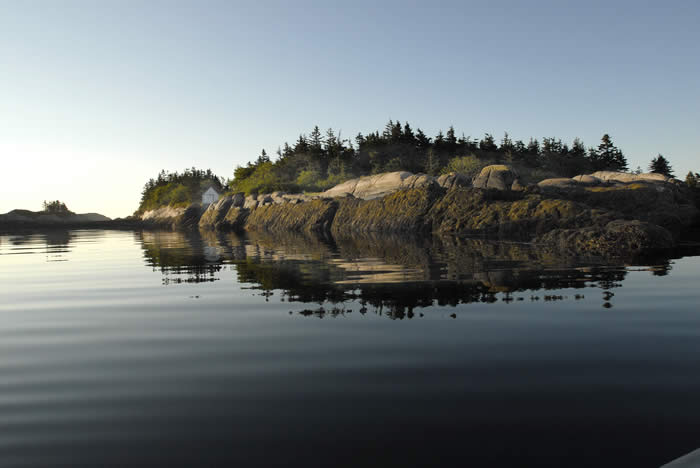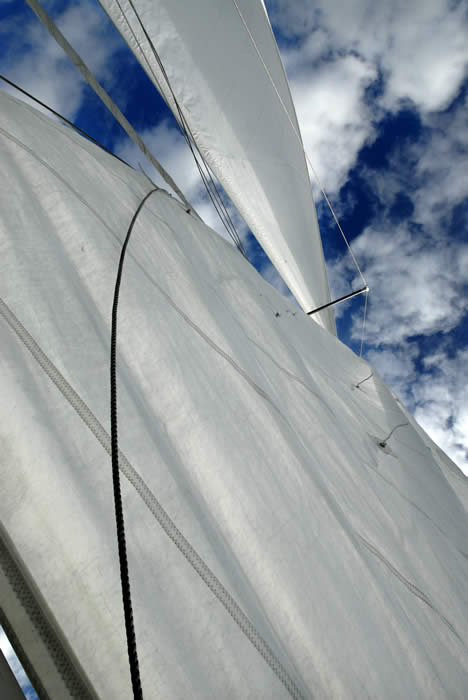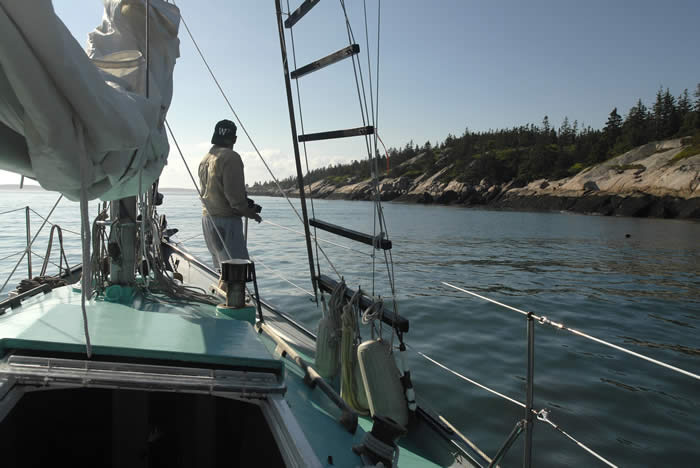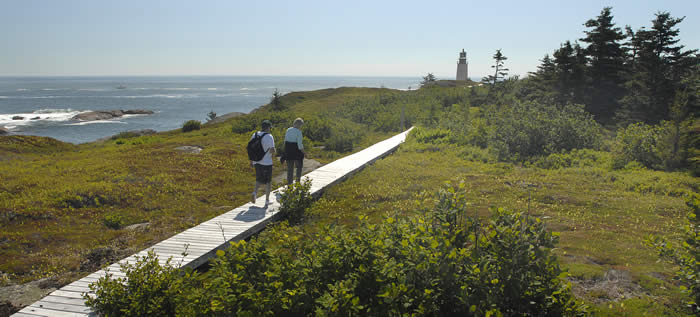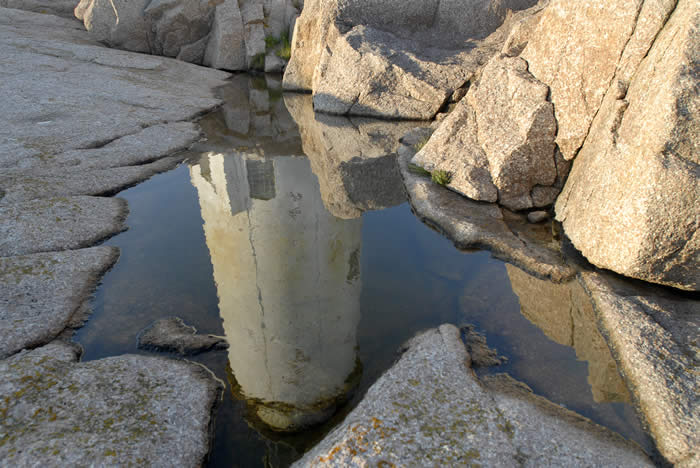Mystery Island
By Sam Low
Sailing Magazine - April, 2009
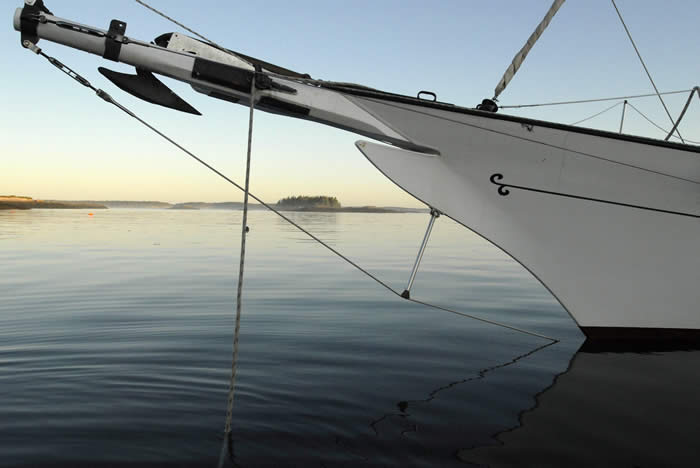
Once past Schoodic Point, the lonely Downeast sailing grounds are hard won. We learn this during a week’s cruise beset with chill winds, fog and more fog – and blessed with landfall on an island shrouded in mystery.
******
A watercolor sky with the Cadillac Mountains drifting by to port under torn gray cloud. Storm petrels dance on the waves. They patter their tiny feet on the swells, drop into the troughs and chandelle in sharp swoops and twists. We forge our way east into the teeth of a cold wind under main, mizzen and jenny. It’s July but it feels like October. It’s uncomfortable at the helm but I’m content to be at sea – a few months earlier I had wondered if I would ever sail again. The pain had started in my chest and expanded rapidly down my left arm. I felt light-headed. I sweated profusely although it was a cool day in April. A heart attack. Luckily, one of Maine’s best cardiac surgeons was in nearby Portland. Even so, by the time he restored blood flow in my left anterior descending artery, twenty percent of my heart muscle was dead. “You’ll have to take it easy,” the doctor told me. Now, sailing into a drizzling rain off Maine’s granite coast, I’m unusually cold even with a winter parka and watch cap. My hands are numb. Beta blockers have slowed my heart rate. My wife Karin plies me with warm soup while my cousin, Val Hart, stands ready to relieve me at the wheel.
We had set out for a week charter from the picturesque village of Somesville aboard Cygnet, a thirty-nine foot ketch designed by Thomas Gilmer (who designed the Pride of Baltimore) and built in 1968 by Joel White (a well-regarded Maine boat builder and the son of famous author E. B. White). She was created for a simpler time when amenities like GPS, radar, showers and pressurized water were distant dreams for everyday yachtsmen. During the ensuing four decades, these features have been retrofitted – leading to some idiosyncrasies. In addition, the boat is somewhat of a misfit for Maine waters. “She was created,” her caretaker told us, “for long-distance cruising in the Caribbean or the South Pacific.” Her ample decks provide room to sprawl under a tropical sun, but to be on deck in chill rain and fog is not a pleasant experience.
Our plans are ambitious – a 200-mile 7-day dash to Cutler and back. Karin and I have sailed Maine waters for more than thirty years, but never east of Schoodic Point – the traditional beginning point of a remote stretch of coast known for its uninhabited islands, deserted beaches and swift-flowing tides. The first night we hole up at Little Cranberry Island and dine in rustic splendor at the Islesford Dock Restaurant, one of our favorite haunts. The next day, with the wind in our teeth, we tuck into Winter Harbor. Two days are gone and we have made good only fifteen miles.
We tack all the way to Schoodic Point with the wind continuing east-northeast – right on our nose – in spite of predictions of southeasterlies. We gingerly cross the bar between the mainland and Petit Manan with its towering lighthouse – heading for Trafton Island. Under power now, Cygnet makes an easy six knots. Reaching the anchorage at Trafton, we find that a sloop and a downeast-style cruising yacht have taken shelter there. We maneuver between them to drop our hook as osprey wheel overhead.
That evening, our Chummy stove purrs with a load of charcoal – spreading its warmth and drying foul weather gear hung overhead. We dine in comfort with flowers, wine and a candle and turn in under heavy blankets. The next day, during breakfast, the sun begins to warm the decks - promising fine weather. We all look forward to Great Wass and, just beyond, to a snug anchorage at Mistake Island. We are underway by ten.
The fog first shows itself astern, swallowing Bois Bubert and Pine Island before sweeping over us in a luminous cloud. The visibility decreases to a hundred yards. Then fifty. Then twenty-five. Under full spread of sail, we make six knots - too fast in these conditions - so we drop the main and tack offshore seeking sea room from hunkering ledges. Should we go on? It’s about twenty-five miles to Great Wass, ten hours at a safe speed in this soup. And once there, we’d be feeling our way into the unfamiliar harbor at Mistake Island with only radar and GPS to guide us. The name – Mistake – seems a bad omen. We decide to return to our familiar anchorage. Plotting GPS coordinates in the main cabin, I guide Val at the helm past a series of dangerous ledges. Ship Stern Island presents a clear radar target as we feel our way into the narrow pass between Tommy Island and Trafton. Then, miraculously, the sun burns through. With a few hours of daylight left, we turn away from our anchorage toward a broad open bay to the southwest.
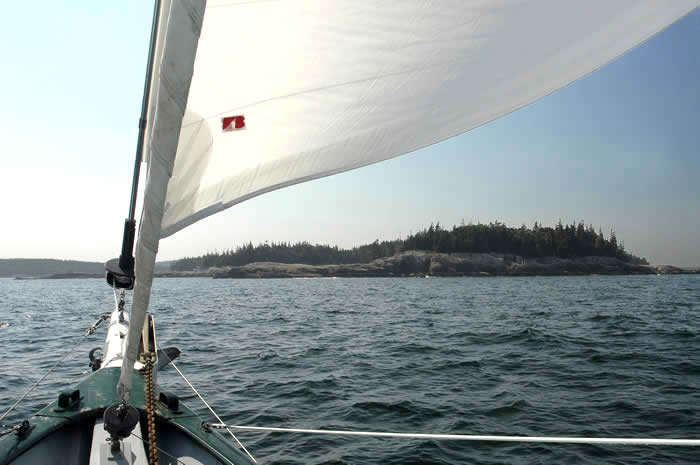
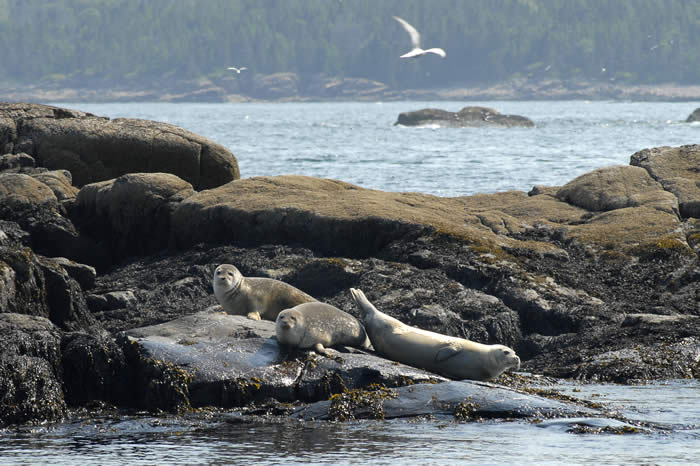
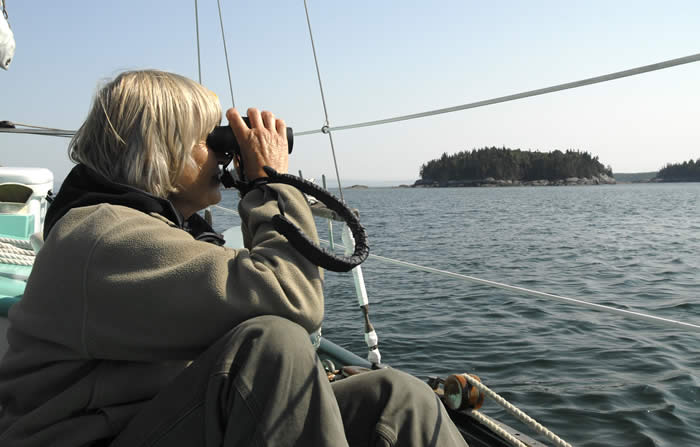
We sail under a bright sun, islands all around us - orange granite contrasting with verdant stands of spruce and fir. A simple house stands bold on a fringe of meadow. Fog still lurks offshore but here we glide in bright waters among a confetti of lobster buoys. Seals lounge on a ledge off Pond Island. Guillemots wheel above. It’s been a day of contrasts – the morning’s white-knuckle bout with fog having given way to one of the most peaceful moments of sailing I can remember. As the old New England saying goes, “if you don’t like the weather, just wait a few minutes.”
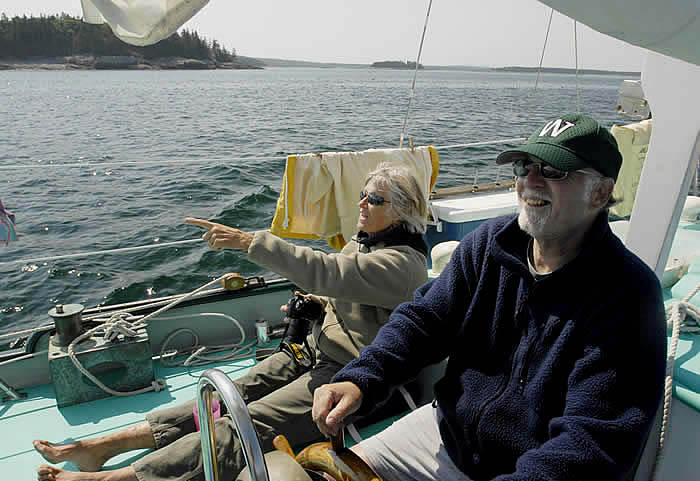
That night I predict the fog will lift, but at dawn on our fourth day I can barely make out the dull outline of the island a hundred feet away. It seems we will be spending the next twenty-four hours wrapped in blankets and cozying up to the Chummy stove. We rummage the books we’ve brought on board.
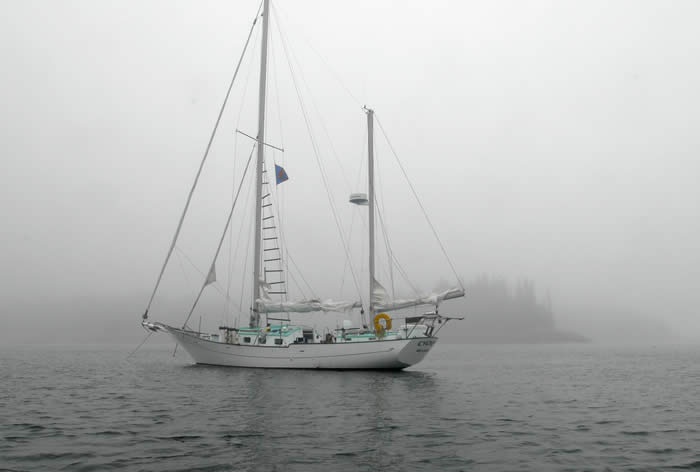
It’s silent in our cocoon of fog save for the cry of osprey or the throb of distant lobster boats. We eavesdrop on the fishermen as they converse via VHF about the day’s catch, the art of greasing a propeller shaft, the merits of local women (we learn that at least one of them needs to be ‘gentled’ quite a bit) or the weather (it’s fog everywhere). The ketch pulls at her anchor in the fog’s circumference. Her life lines drip. Confined to this tiny space for the day, with no place to go, we elaborate the small rituals of food preparation and tending the stove. We chat, read to each other and fall silent for long periods. We have sailed these waters enough to know that when nature takes over you must deploy patience to accommodate her.
Cygnet’s main cabin is “Herreshoff style,” painted white with varnished mahogany trim. Her bulkheads are nicely curved. Small brass lamps provide lighting. The galley is tiny and occasionally the target of Karin’s wrath as she struggles to prepare our meals without dumping a dish on the cabin sole. I dub the aft cabin, where Val sleeps, the “Hobbit hole” because it offers only sitting headroom. Yet the two bunks are more than adequate and it’s a snug place in grim weather. Val settles in and pronounces himself very happy with it, though somewhat miffed at being called a hobbit. .
On Thursday, Bar Harbor reports fog. So does Saint John, Halifax and Fredericton. “Yesterday I didn’t even go out,” a fisherman declares on the VHF, “built me a real fire and sat by it and got zonkered.” NOAA weather predicts the fog will hold for the morning, then clear in the afternoon. Friday and Saturday will be either “mostly sunny” or “partly sunny.” Sure enough, the fog dissipates as the morning progresses. Soon, we can see both ends of Trafton Island. The coffee perks on the stove and Val serves breakfast. The fog lifts, rolls in, lifts, then blots out the island once more. We go over our charts. With only three days left, what should we do – continue east or turn back toward home? Even in the worst of fog, the upper part of Blue Hill Bay (only about 15 miles back the way we came) often remains clear – providing an opportunity to sail freely. And Penobscot Bay offers many anchorages that are easy of access in the thickest of soup. The entrance to Mistake Island, on the other hand, is dangerous in poor visibility - even with GPS and radar – and there are no real anchorages between it and Trafton. The weather report is favorable but the south wind blows cool from the ocean and that often means yet more fog. But the crew, having spent an entire day at anchor, is restless. “Let’s at least go out and take a look,” says Karin.
About five miles from Trafton, heading toward Great Wass, the fog socks in again. We continue on, following our dead reckoning track under power as I scan the radar for lobster boats dervishing around us, out of sight in the soup. I feel a slight pain in my chest. It has been with me on occasion ever since the heart attack – and it comes when I am stressed. I have always been a cautious sailor – one who envisions the dangers all around to better avoid them. I have sailed in fog plenty of times, and in much more difficult circumstances, but now I find myself uncharacteristically wary. About one o’clock, I ask Val to shut down the engine. Radar shows the bell off Egg Rock is only about a hundred yards away – we can hear it clearly but it’s hidden in the fog. Creeping closer, it suddenly appears twenty-five feet off the bow.
“That’s it,” I tell the crew, “I’m not taking us to Mistake in this stuff. We’ll have to go back.”
“Why not wait an hour or so to see what happens?” Val suggests. He’s right – we have plenty of time – I have been too anxious for the security of the familiar. So we heave to and drift among lobster buoys, munching tuna fish sandwiches. Cygnet wallows in southerly swells. I man the radar, watching tiny blips maneuver close aboard all around us. On deck, Val and Karin track the lobster boats by their sound. We never see them even though radar shows they approach to within a few hundred yards. The sun tries to work through the gray scrim overhead. The sky lightens, then closes up again. Lobstermen may know these waters and their sunken ledges like the backs of their hands – but I do not. At two-thirty in the afternoon I set a course back to Trafton. Once again we retreat to the west.
Ten minutes later, Val calls down to me as I plot our positions on the nav table below: “Sam, come on deck and take a look at this.” Gaining the deck, I am amazed to see the fog has cleared entirely. All of a sudden, it’s a beautiful sunny day. We swing the boat around again to the northeast. Mistake Island, here we come - finally.
Great Wass island meets the sea in a fringe of small granite outcrops that are barren seaward then crested with spruce as they hump beyond the line of spray. The fog has lifted, revealing a mackerel sky with ample patches of blue. The sun peeks between the clouds. Val is at the helm (we have taken to calling him “iron man” because of his long stints at the wheel) while Karin and I lounge in the unaccustomed warmth that envelops us. Our destination is marked by a tall lighthouse on Mistake Island. The moan of its horn reaches out to us as we ghost along with all sails set.
As we enter the narrows between Mistake and Steele Harbor Island, a deep swell works against the outgoing tide and Cygnet pitches sensually. To starboard, sea-smoothed cliffs contest the swells - orange in the fading sunlight – round shapes sculpted by a rounded ocean.
“I have never seen such a beautiful place,” says Karin.
We have cruised the bays of Casco, Muscongus and Penobscot for many years and each time we’ve discovered new delights - declaring each of them yet more beautiful. But when we finally reach Mistake Island, after so many aborted attempts, the place seems a miracle. Moose Peak light stands starkly against the sky behind us and ahead, in the path of the setting sun, the sea gives back a sequined glow that warms us to our bones. The anchorage is both secure and fragile. Like a South Pacific reef standing against Trade Wind surf, unnamed islets barely rise above the ocean’s grasp at high tide. We drop our hook in sixteen feet of water and set it amidst dozens of lobster buoys. The sun splashes the sea gold and silver. We are elated to finally be here – and to have this beautiful anchorage all to ourselves.
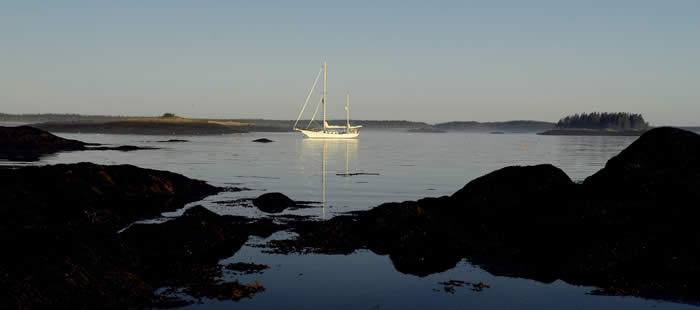
On a tour of Mistake, we find that the Nature Conservancy has built a boardwalk up to the lighthouse. Under the Conservancy’s stewardship, lichens, moss and wild iris have carpeted sea-worn boulders in subtle shades of purple, green, tan and luminous orange. Straying from the boardwalk to take photographs, my feet are cushioned in vegetation that must have required decades to flourish. I ask forgiveness with each step – yet I cannot resist the vistas that open to sea and polished rock. A cellar hole ornamented with rusting detritus must be the remains of the light keeper’s cottage – the light and horn having been automated thirty-five years ago. Further on, pools of water reflect the lighthouse itself, gleaming in the wan rays of the setting sun. We feel the power of nature all around us in the surging tides, the wind-driven mist, the lichen clinging to boulders. The earth radiates warmth; the wind carries cool droplets against our skin; the surf roars on the tawny coast. The sun descends. It’s time to turn back to the ketch.
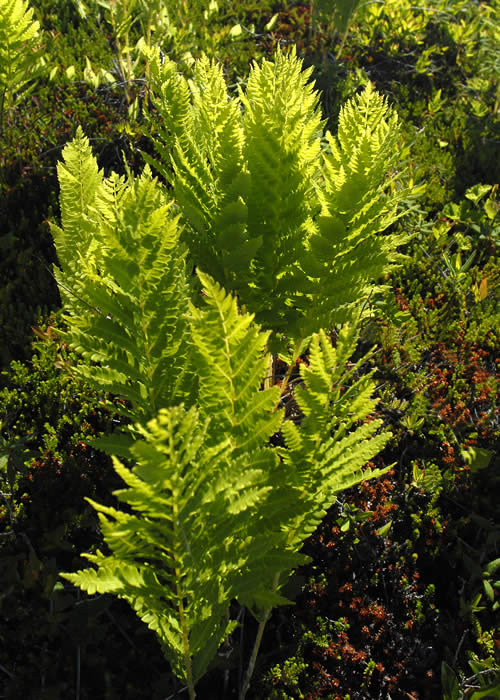
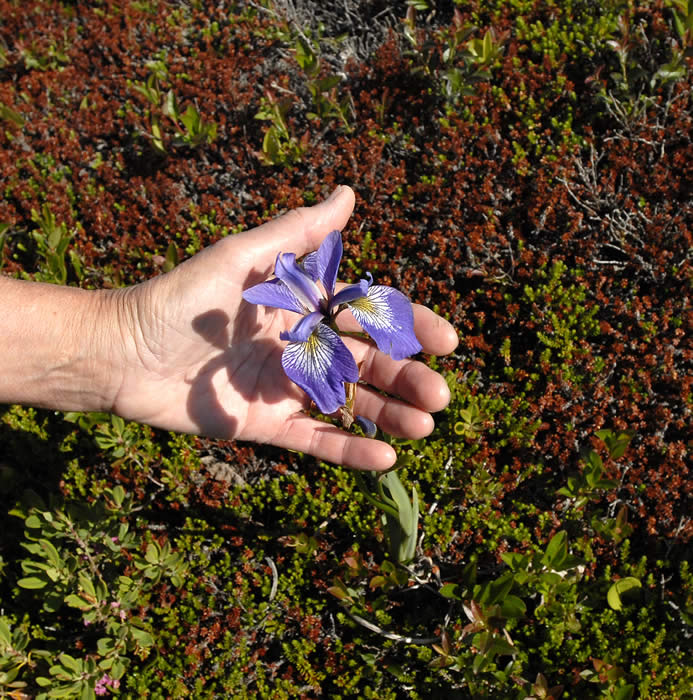
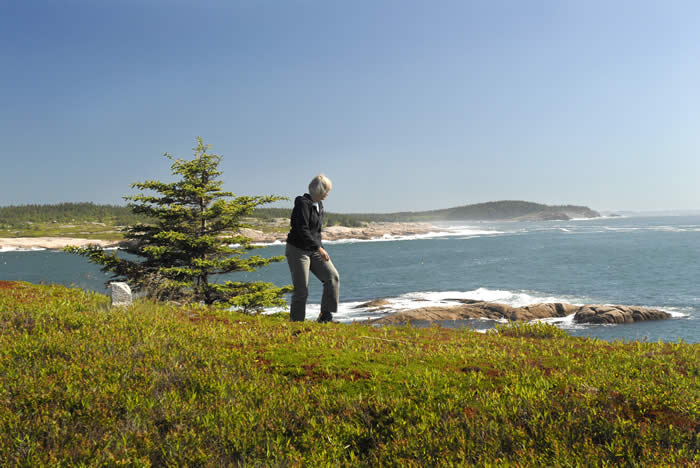
Karin has stayed behind because the tide was coming in so fast there was no place to safely tie the dingy. As she waited, the island’s peaceful aura stirred her memory of friends who have crossed the bar. She spent her time building small cairns to their spirits. Then she watched the tide quickly cover them. We begin to call this place Mystery Island, a name inspired by a puzzle that lurks in the corners of our minds - why is this place so ethereal?
When we settle in for the night, the tide is high and Cygnet tugs at her anchor in swells that sweep over the reefs around us. At five AM, at low tide, I awake to find the ketch perfectly still in a mill pond surrounded by high land on all sides. There’s a rank but not unpleasant odor - seaweed – exposed by the falling tide. The sun begins to paint the anchorage. Gulls palaver and take to the air on dawn patrols. It promises to be a beautiful day.
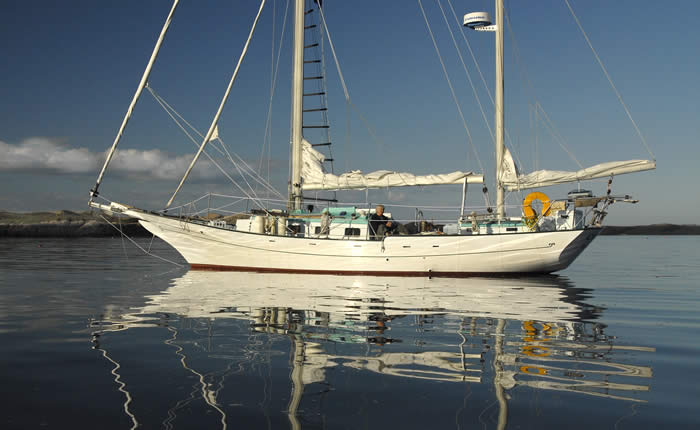
To the west, a single necklace of cloud hangs in the distance over the serrated backbone of Great Wass. I reconnoiter in the dingy, dipping my oars gently in the still waters, braced by the chill air and the muffled beat of surf. Cygnet is a beautiful sight, her clipper bow arcing into the sky, her long bowsprit a slender punctuation mark. She has brought us safely here and we are grateful to her. A lobster boat throbs in the distance, making its way from Jonesport, through the narrows and out to the fishing grounds. I scan the ocean for other yachts – we have not seen a single sail since passing Schoodic Point – but the horizon continues to be empty.
